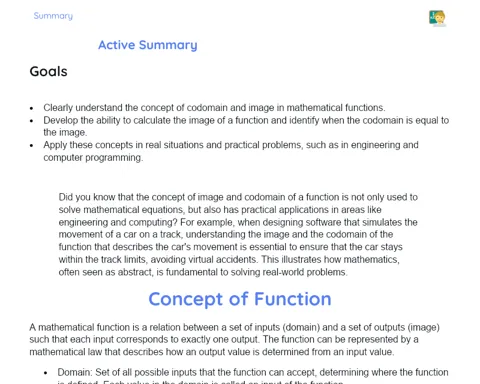Connecting Geometry with the Real World: Parallel Lines and Transversals in Action
Objectives
1. Relate the angles formed by parallel lines cut by a transversal.
2. Identify alternate interior angles, corresponding angles, and interior consecutive angles, checking which are equal and which are supplementary.
Contextualization
Parallel lines cut by a transversal are a fundamental concept in geometry, but their application goes far beyond math classes. Imagine a civil engineer designing a bridge or an architect drawing a building; precision in angles and lines is crucial to ensure the safety and stability of structures. For example, in a bridge, parallel lines may represent support cables, while the transversal may be a support beam. Understanding how angles relate can make all the difference in executing real projects.
Relevance of the Theme
Precision in angles is essential not only to ensure the safety and stability of constructions but also in areas such as robotics, game programming, and design. Understanding the angles formed by parallel lines cut by a transversal is a highly valued skill in the job market, especially in careers involving engineering, architecture, and technology. Mastering these concepts allows for the creation of safer and more efficient structures and systems.
Parallel Lines
Parallel lines are two or more lines that, being in the same plane, do not intersect, regardless of how far they are extended. This concept is fundamental in geometry and has various practical applications in engineering and architecture, where the precision and stability of structures depend on correct parallel lines.
-
Parallel lines never meet.
-
The distance between two parallel lines is constant.
-
They are essential in engineering and architecture projects to ensure structural precision.
Transversal
A transversal is a line that crosses two or more lines at distinct points. When a transversal cuts parallel lines, it forms specific angles that are important for various practical applications. This concept is particularly useful in civil construction, where transversals help determine precise measurements and correct alignments.
-
A transversal cuts two or more lines at distinct points.
-
When it cuts parallel lines, it forms important angles: alternate interior angles, corresponding angles, and interior consecutive angles.
-
Used to determine precise measurements and alignments in engineering projects.
Formed Angles
When a transversal cuts parallel lines, angles are formed that have specific relationships: alternate interior angles, corresponding angles, and interior consecutive angles. Understanding these relationships is essential to ensure precision in calculations and engineering and architecture projects.
-
Alternate interior angles: are equal and located on opposite sides of the transversal.
-
Corresponding angles: are also equal and are on the same side of the transversal.
-
Interior consecutive angles: are supplementary, meaning their sum is 180 degrees.
Practical Applications
- Civil Construction: Precision in angles to ensure the stability and safety of structures.
- Robotics: Programming precise and realistic movements using angles formed by parallel lines cut by a transversal.
- Game Design: Using angles to create realistic movements and interactions between objects in the virtual environment.
Key Terms
-
Parallel Lines: Two or more lines in the same plane that never meet.
-
Transversal: A line that cuts two or more lines at distinct points.
-
Alternate Interior Angles: Equal angles formed on opposite sides of the transversal.
-
Corresponding Angles: Equal angles located on the same side of the transversal.
-
Interior Consecutive Angles: Supplementary angles whose sum is 180 degrees.
Questions
-
How can precision in identifying the angles formed by parallel lines cut by a transversal impact the safety of a construction?
-
In what ways are the concepts of angles formed by parallel lines cut by a transversal applied in robot programming?
-
How can knowledge about angles formed by parallel lines cut by a transversal be used to improve game design projects?
Conclusion
To Reflect
The lesson on parallel lines cut by a transversal showed us the importance of angles in geometry and their numerous practical applications. Understanding how these angles relate is not only a theoretical exercise but an essential skill for various professions, such as engineering, architecture, and technology. Precision in angular calculations can determine the safety and efficiency of structures and systems, from buildings and bridges to robots and video games. Reflecting on this connection between theory and practice helps us value mathematical learning and understand its impact on our lives and future careers.
Mini Challenge - Practical Challenge: Building a Geometric Structure
To consolidate the understanding of the angles formed by parallel lines cut by a transversal, we will build a geometric structure using simple materials.
- Gather the necessary materials: skewers, hot glue, ruler, and graph paper.
- Draw on graph paper two parallel lines and a transversal that cuts them.
- Identify and mark the alternate interior angles, corresponding angles, and interior consecutive angles on the drawing.
- Use the skewers and hot glue to build a three-dimensional structure representing the drawing made on graph paper.
- Check if the angles in the constructed structure correspond to the angles identified on the paper.
- Take a photo of your structure and make a brief presentation explaining how you applied the concepts of angles in the construction.



